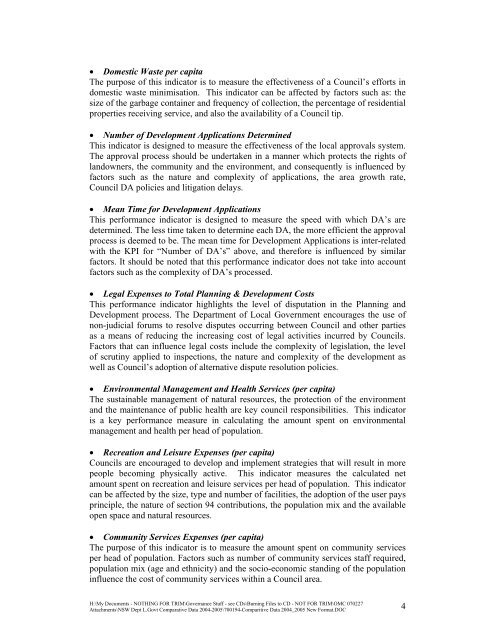27 February 2007 - Ordinary Meeting of Council (pdf. 14MB)
27 February 2007 - Ordinary Meeting of Council (pdf. 14MB)
27 February 2007 - Ordinary Meeting of Council (pdf. 14MB)
Create successful ePaper yourself
Turn your PDF publications into a flip-book with our unique Google optimized e-Paper software.
• Domestic Waste per capita<br />
The purpose <strong>of</strong> this indicator is to measure the effectiveness <strong>of</strong> a <strong>Council</strong>’s efforts in<br />
domestic waste minimisation. This indicator can be affected by factors such as: the<br />
size <strong>of</strong> the garbage container and frequency <strong>of</strong> collection, the percentage <strong>of</strong> residential<br />
properties receiving service, and also the availability <strong>of</strong> a <strong>Council</strong> tip.<br />
• Number <strong>of</strong> Development Applications Determined<br />
This indicator is designed to measure the effectiveness <strong>of</strong> the local approvals system.<br />
The approval process should be undertaken in a manner which protects the rights <strong>of</strong><br />
landowners, the community and the environment, and consequently is influenced by<br />
factors such as the nature and complexity <strong>of</strong> applications, the area growth rate,<br />
<strong>Council</strong> DA policies and litigation delays.<br />
• Mean Time for Development Applications<br />
This performance indicator is designed to measure the speed with which DA’s are<br />
determined. The less time taken to determine each DA, the more efficient the approval<br />
process is deemed to be. The mean time for Development Applications is inter-related<br />
with the KPI for “Number <strong>of</strong> DA’s” above, and therefore is influenced by similar<br />
factors. It should be noted that this performance indicator does not take into account<br />
factors such as the complexity <strong>of</strong> DA’s processed.<br />
• Legal Expenses to Total Planning & Development Costs<br />
This performance indicator highlights the level <strong>of</strong> disputation in the Planning and<br />
Development process. The Department <strong>of</strong> Local Government encourages the use <strong>of</strong><br />
non-judicial forums to resolve disputes occurring between <strong>Council</strong> and other parties<br />
as a means <strong>of</strong> reducing the increasing cost <strong>of</strong> legal activities incurred by <strong>Council</strong>s.<br />
Factors that can influence legal costs include the complexity <strong>of</strong> legislation, the level<br />
<strong>of</strong> scrutiny applied to inspections, the nature and complexity <strong>of</strong> the development as<br />
well as <strong>Council</strong>’s adoption <strong>of</strong> alternative dispute resolution policies.<br />
• Environmental Management and Health Services (per capita)<br />
The sustainable management <strong>of</strong> natural resources, the protection <strong>of</strong> the environment<br />
and the maintenance <strong>of</strong> public health are key council responsibilities. This indicator<br />
is a key performance measure in calculating the amount spent on environmental<br />
management and health per head <strong>of</strong> population.<br />
• Recreation and Leisure Expenses (per capita)<br />
<strong>Council</strong>s are encouraged to develop and implement strategies that will result in more<br />
people becoming physically active. This indicator measures the calculated net<br />
amount spent on recreation and leisure services per head <strong>of</strong> population. This indicator<br />
can be affected by the size, type and number <strong>of</strong> facilities, the adoption <strong>of</strong> the user pays<br />
principle, the nature <strong>of</strong> section 94 contributions, the population mix and the available<br />
open space and natural resources.<br />
• Community Services Expenses (per capita)<br />
The purpose <strong>of</strong> this indicator is to measure the amount spent on community services<br />
per head <strong>of</strong> population. Factors such as number <strong>of</strong> community services staff required,<br />
population mix (age and ethnicity) and the socio-economic standing <strong>of</strong> the population<br />
influence the cost <strong>of</strong> community services within a <strong>Council</strong> area.<br />
H:\My Documents - NOTHING FOR TRIM\Governance Stuff - see CDs\Burning Files to CD - NOT FOR TRIM\OMC 0702<strong>27</strong><br />
Attachments\NSW Dept L.Govt Comparative Data 2004-2005\700194-Comparitive Data 2004_2005 New Format.DOC<br />
4
















